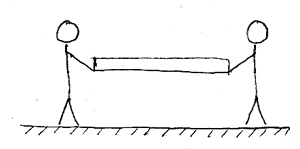
| MadSci Network: Engineering |
The full answer to this question requires a little basic physics, some algebra, and a pinch of art, but I'll do my best to explain it in English along the way as well. I'll step through a few examples as I go to build to your answer.
The first step in solving this type of problem is to draw a free-body diagram. A free-body diagram is simply a picture of the object in question, with a list of all of the forces acting upon it. For the first example, let's imagine 2 people carrying a sheet of plywood on level ground like this (please pardon my art skills):

So the free-body diagram would look like this:
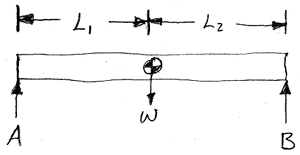
Where "A" and "B" are the forces exerted by the 2 movers and "W" is the weight of the object, acting at its center of gravity. Now, since this is a static situation (nothing is moving or accelerating), the total sum of all forces must be zero. If the sum were not zero, then it would accelerate (by Newton's Second Law of Motion). Therefore:
A + B - W = 0In other words, the forces exerted by the 2 movers must be equal to the weight of the object they are moving.
A + B = W
There is one more condition. The sum of the moments must also be zero. Some people will also call a moment a torque. A moment is simply a turning force, like turning a nut with a wrench. You apply a force to the end of the wrench, and it turns the nut: that's a moment. In physics, a moment is defined as the product of a force and the distance to the turning axis (force x distance). In a static free body diagram, you can calculate your moments about any point. I will choose the center of gravity of the board just for convenience. Therefore:
A * L1 - B * L2 + W * 0 = 0Notice that A is added while B is subtracted. That's because they are working in opposite directions: A is trying to turn the board clockwise, while B is trying to turn the board counter-clockwise.
A * L1 = B * L2
Anyway, if L1 = L2 (the center of gravity is at the center of the board), then the 2 equations simplify to:
A + B = WSo A = ½ W and B = ½ W. That's probably what you expected all along. Each person carries half the weight. So now let's go down some stairs like this:
A = B
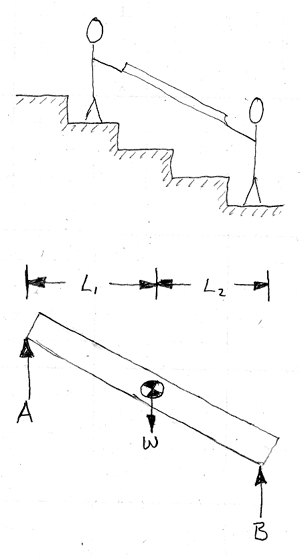
When you look at it like this, it doesn't look much different. In fact, it's not different at all. As long as the center of gravity is still half way between the two movers, they still carry equal weight; even if they are on different levels.
Now, here comes the real difference. What if they're carrying something larger? For sake of art (or lack-there-of), let's just assume it's a really big box (which is easier to draw than a piano).
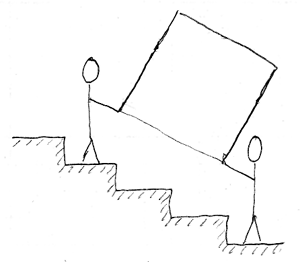
Maybe you already see what's happening. Once you draw the free body diagram, it becomes even more obvious:
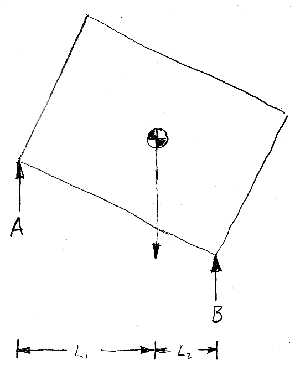
Look at what happened to the center of gravity. With a higher center of gravity, the more you tilt it back, the more it's center shifts to the point that it is no longer in the middle of its base. Our sum of forces are still the same, but this distances are no longer equal. So this time we end up with this pair of equations:
A + B = WA little bit of algebra, and we end up with:
A * L1 = B * L2
A = W * (L2 / (L1 + L2))In other words, the weight each person carries, is proportional to how close they are to the center of gravity. The person who is the closest carries the most weight, and the person who is farther away gets less.
B = W * (L1 / (L1 + L2))
I hope that all makes sense and it answers your question.
Your Mad Scientist,
Mike Scannell
Try the links in the MadSci Library for more information on Engineering.